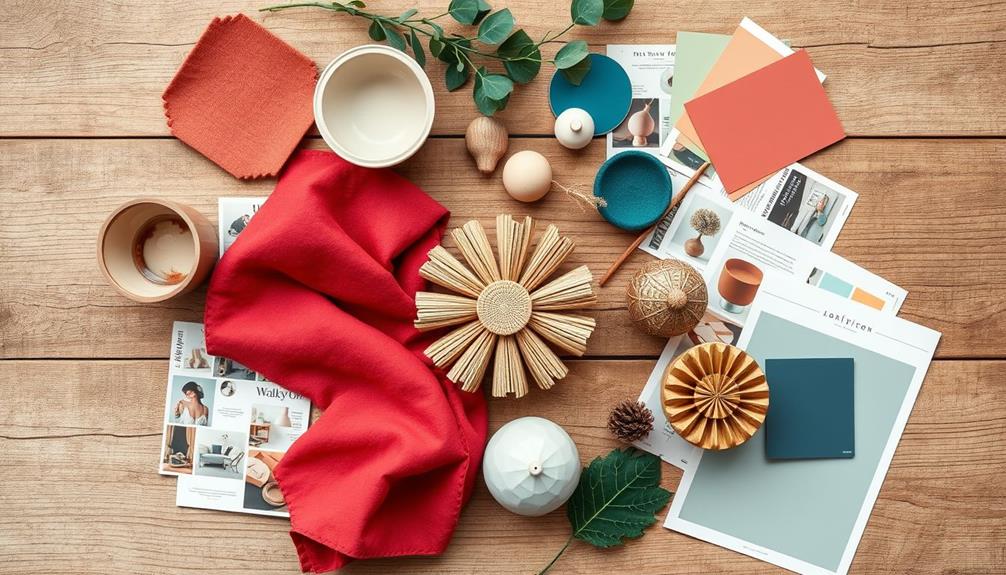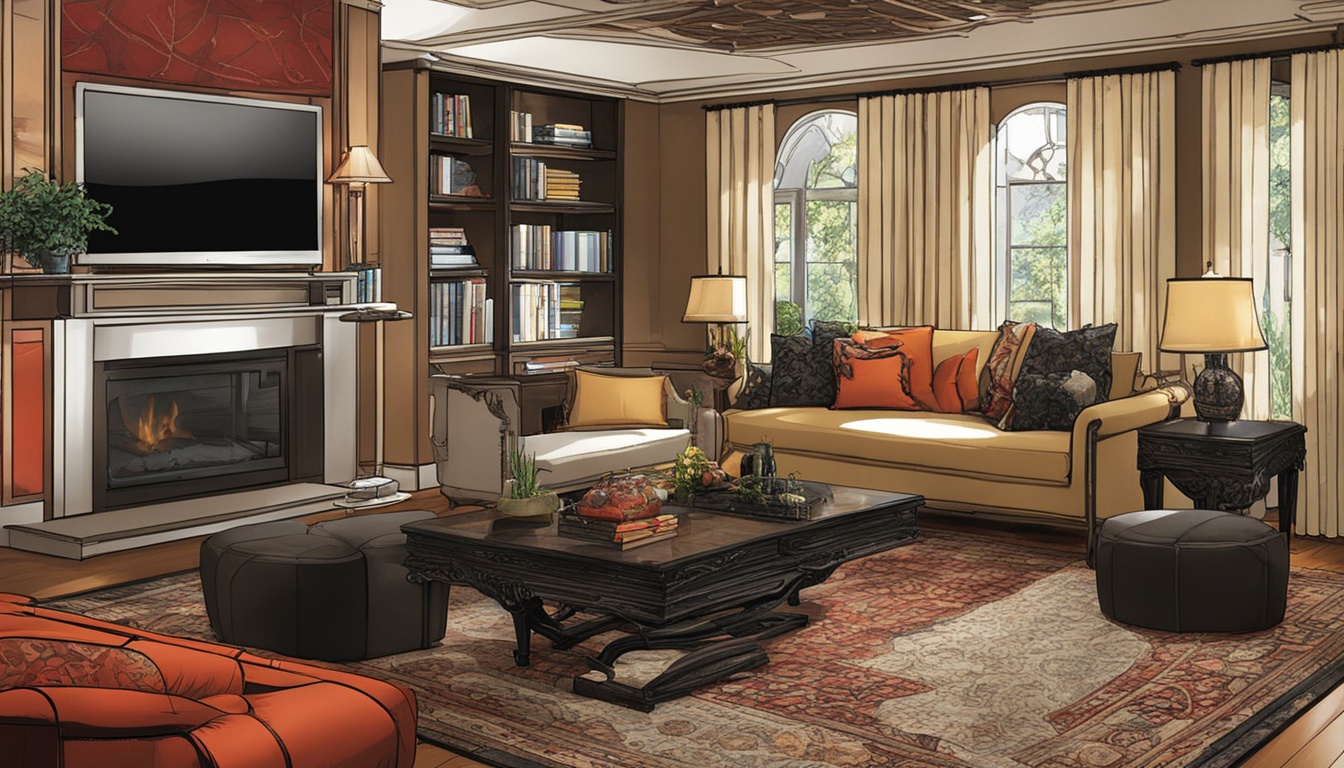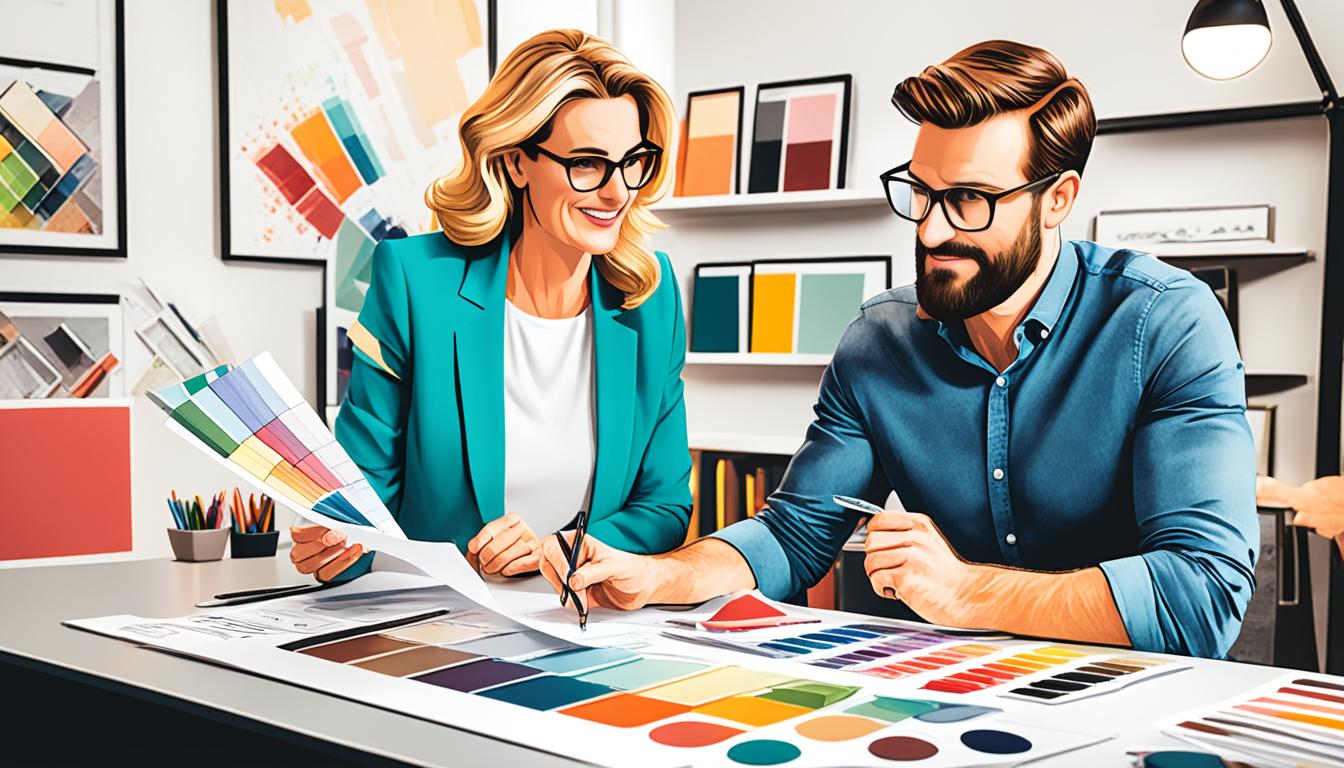You can use AI for interior design in several impactful ways. Start by utilizing tools like MidJourney and DALL·E 2 to generate visual concepts from text prompts, making it easy to visualize ideas. Explore Homevisualizer AI for user-friendly design creation and REimagine Home AI for rapid staging. These tools provide personalized recommendations by analyzing data, enhancing client satisfaction. While AI offers inspiration, remember that human input is essential for final designs. Embracing these technologies not only boosts creativity but also streamlines workflows. There's more to uncover about integrating AI in your design process. Additionally, AI can be used to analyze trends and preferences in interior design, providing valuable insights for your business. By leveraging AI-powered tools, you can gain a competitive edge by staying ahead of industry shifts and understanding customer preferences. These technologies also offer tips for interior design business, helping you improve your marketing strategies and optimize your product offerings to better cater to your target market. Embracing AI in your interior design business can lead to improved efficiency, greater customer satisfaction, and ultimately, increased success in the industry.
Key Takeaways
- Utilize AI tools like MidJourney and DALL·E 2 to generate visual concepts from text descriptions for better client engagement.
- Implement Homevisualizer AI for user-friendly, realistic design creation that simplifies the design process for all users.
- Leverage generative design algorithms to quickly produce multiple design options tailored to specific client preferences and requirements.
- Use AI for virtual staging and redesigns to facilitate rapid transformations and enhance decision-making in interior design projects.
- Analyze audience insights and engagement metrics on social media to optimize the presentation of AI-generated design visuals.
What Is AI in Design?
AI in design isn't just a futuristic concept; it's a powerful tool that's transforming how interior designers work. By utilizing artificial intelligence, you can mimic human cognitive functions like learning and reasoning, enhancing your creative process. AI tools analyze design trends and user preferences, making your projects more efficient and innovative.
Generative design algorithms stand out as a key feature of AI in interior design. These algorithms allow you to input specific parameters and rapidly generate multiple design options, saving you time while expanding your creative possibilities. Imagine the flexibility you gain when brainstorming ideas or considering various styles!
Moreover, tools like MidJourney and DALL·E 2 empower you to create stunning visual renderings from simple textual descriptions. This capability not only streamlines your creative process but also enhances client engagement, as you can present vivid images of your concepts in a matter of minutes.
As the market for AI in design is projected to grow considerably, adapting to these technologies will be imperative for staying competitive. Embracing AI means you're not just keeping pace with trends; you're leading the charge into the future of interior design.
Essential AI Tools for Designers

Interior designers increasingly rely on essential AI tools to streamline their workflow and enhance creativity. These AI interior design tools not only simplify the design process but also provide personalized recommendations tailored to your specific needs.
Here's a quick overview of some standout tools:
| Tool Name | Key Features | Ideal Use Case |
|---|---|---|
| MidJourney | Transforms text descriptions into images | Concept visualization |
| Homevisualizer AI | User-friendly interface for realistic designs | Accessible design for all |
| REimagine Home AI | Instant virtual staging and redesigns | Quick room transformations |
With tools like DALL·E 2 generating visuals from prompts and ChatGPT offering design insights, you can make informed decisions efficiently. ZMO AI even creates personalized interior ideas based on uploaded photos, giving you quick iterations. For instant customization, RoomsGPT.io allows you to modify room photos with various themes, delivering realistic outputs in seconds. Using these user-friendly interfaces can greatly boost your creativity and effectiveness in room design.
Benefits of AI in Interior Design
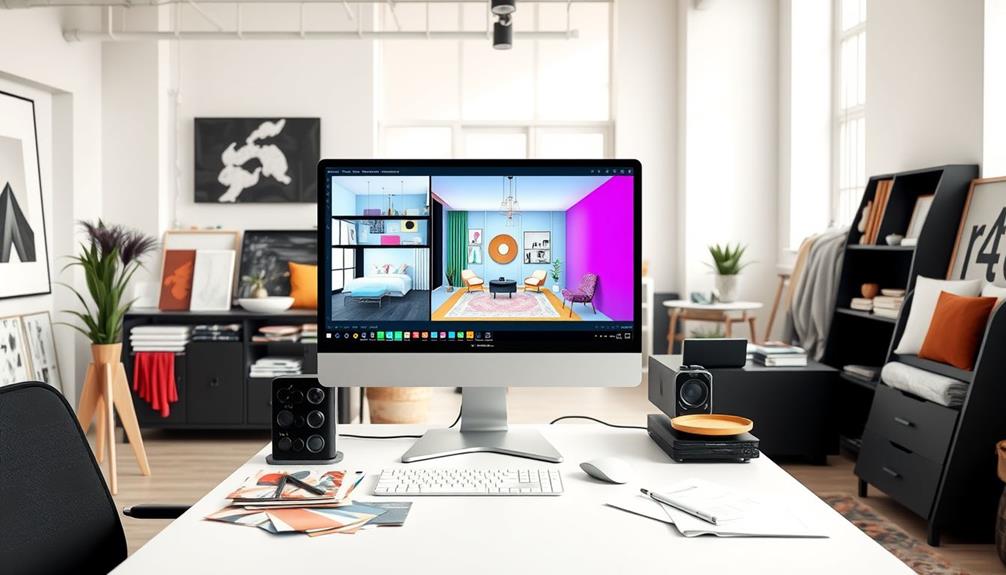
Increasingly, designers find that leveraging AI in their projects markedly enhances efficiency and creativity. By automating manual tasks, you can save time and focus on innovative ideas.
Additionally, integrating AI advancements into your workflow can lead to more effective design solutions while addressing important ethical considerations. Here are three key benefits of using AI in interior design:
- Personalized Design Recommendations: AI analyzes user data to provide tailored suggestions that resonate with your clients' preferences, boosting satisfaction.
- Realistic Renderings: You can quickly generate high-quality visualizations, enabling faster decision-making and approvals, streamlining the design process.
- Sustainability: AI helps optimize material usage and promotes eco-friendly practices, ensuring your designs aren't only beautiful but also environmentally responsible.
Moreover, the integration of AI in project management enhances collaboration between you and your clients, leading to improved workflow productivity.
With AI handling mundane tasks, you can devote more energy to creativity and innovation, ultimately transforming your interior design projects.
By embracing AI, you're not just keeping up with trends; you're setting them, ensuring your designs are efficient, personalized, and sustainable.
Embrace the future of interior design and watch your creativity soar.
Limitations of AI Technologies

While AI technologies promise to revolutionize design processes, they also come with notable limitations that designers must navigate.
For starters, tools like MidJourney and DALL·E 2 primarily serve as sources of inspiration rather than complete design solutions. You'll often find yourself needing human intervention to achieve realistic visualizations and detailed designs. Many AI programs struggle with modifying existing images or accurately redesigning spaces, which can lead to unrealistic or impractical outcomes.
The quality of results generated by AI heavily depends on the input data; if the data is inaccurate or insufficient, you might end up with subpar designs. Additionally, AI technologies currently face challenges in truly understanding human emotions and aesthetics, limiting their effectiveness in creating designs that resonate with users.
Moreover, the high initial investments required for advanced AI systems, combined with concerns about job displacement in creative fields, present significant barriers to widespread adoption in interior design.
Future Trends in AI Design

As you explore the future of interior design, generative design algorithms will likely transform how you create spaces, allowing for more personalized and innovative layouts.
You'll also notice smart home integration becoming a standard feature, seamlessly blending design with automation for enhanced functionality.
These trends promise to elevate your design experience and meet the evolving needs of modern living.
Generative Design Algorithms
In the domain of interior design, generative design algorithms are revolutionizing the creative process by leveraging artificial intelligence to explore a multitude of design possibilities tailored to your specific parameters.
These algorithms analyze vast data, considering material properties, environmental factors, and user preferences, enabling you to achieve innovative solutions that would be difficult to replicate manually. Additionally, incorporating sustainable energy solutions such as geothermal energy can enhance the overall environmental consciousness of your design projects.
Using generative design can help you:
- Reduce material waste, promoting sustainability in your projects.
- Enhance creativity by providing an array of design options that inspire fresh ideas.
- Maximize functionality and aesthetics, ensuring your space is both beautiful and practical.
The integration of AI in design is set to grow considerably, with a projected market growth rate of 42% CAGR from 2021 to 2028.
As future advancements unfold, expect improved user interfaces and sophisticated algorithms that factor in emotional and aesthetic elements, making AI-generated designs even more appealing.
Generative design algorithms not only streamline your design process but also align with eco-friendly practices, enhancing your project's impact while fostering a deeper connection to the spaces you create.
Smart Home Integration
Smart home integration is transforming how you approach interior design, making spaces more adaptive and personalized. With advanced smart home technologies, AI systems can now customize your lighting, temperature, and security settings based on your unique user preferences.
Imagine coming home to the perfect ambiance, tailored just for you, thanks to these intelligent systems. As leaders in this field showcase successful outcomes, testimonials enhance credibility and trust in these technologies.
AI-driven solutions analyze data from sensors to optimize room layouts and functionality, enhancing your overall living experience. As generative design algorithms become more prevalent, you'll easily visualize your smart spaces, ensuring seamless integration of technology into your interior design.
The rise of smart appliances and furniture that communicate with AI not only streamlines operations but also elevates the aesthetic appeal of your living space.
Picture your refrigerator reminding you when to restock, or your sofa adjusting its comfort based on your sitting habits.
With the smart home market projected to grow considerably, expect substantial advancements in user interface and personalization features.
These innovations will provide you with even more control over your environment, making your interior design not just stylish but also incredibly functional. Embrace this future, and let AI enhance your home.
How to Use MidJourney

When diving into the world of interior design with MidJourney, you'll want to craft detailed text descriptions of your desired elements to achieve the best results. The more specific you are, the more accurately MidJourney can generate images that reflect your vision.
To get started, consider these essential tips:
- Define Your Design Elements: Describe the furniture, colors, and textures you envision for your space.
- Specify Visual Aesthetics: Are you leaning toward a modern, rustic, or minimalist style? Your choice will influence the creative outputs.
- Engage with the Community: Connect with other MidJourney users to share insights and refine your prompt writing skills.
Using MidJourney's intuitive interface, you can easily refine and iterate your designs based on initial outputs. This allows you to align more closely with your vision before moving forward.
Additionally, take advantage of MidJourney's ability to create preliminary visualizations, which can streamline the design approval process. By harnessing AI effectively, you'll transform your interior design concepts into enthralling visual representations.
Utilizing DALL·E 2 Effectively
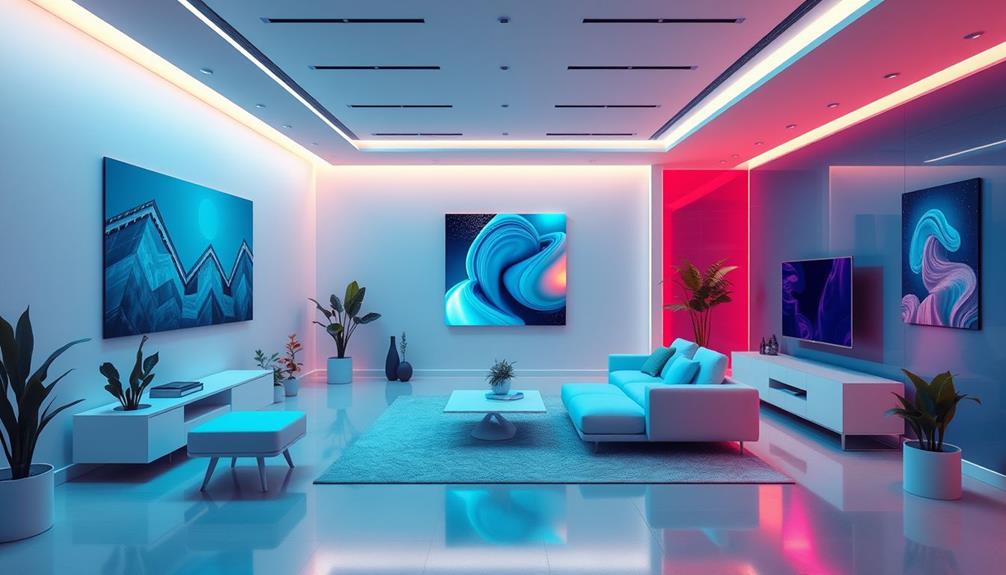
To harness the full potential of DALL·E 2 for interior design, start by crafting detailed text prompts that capture your vision. Include specific elements like furniture styles, color schemes, and themes to guarantee accurate image generation. This precision helps DALL·E 2 visualize your design concepts effectively.
Maximize the quality of your outputs by specifying the desired image style, whether it's photography or digital art. Don't forget to detail background elements, camera angles, and lighting conditions. This level of customization enhances the realism and appeal of the generated images.
Use DALL·E 2 to create mood boards by inputting descriptions of your desired aesthetics. These serve as valuable tools for clients, helping them visualize design concepts before final decisions.
Additionally, consider commissioning custom artwork; provide specific references to tailor unique elements to individual design needs.
Strategies for Social Media Engagement
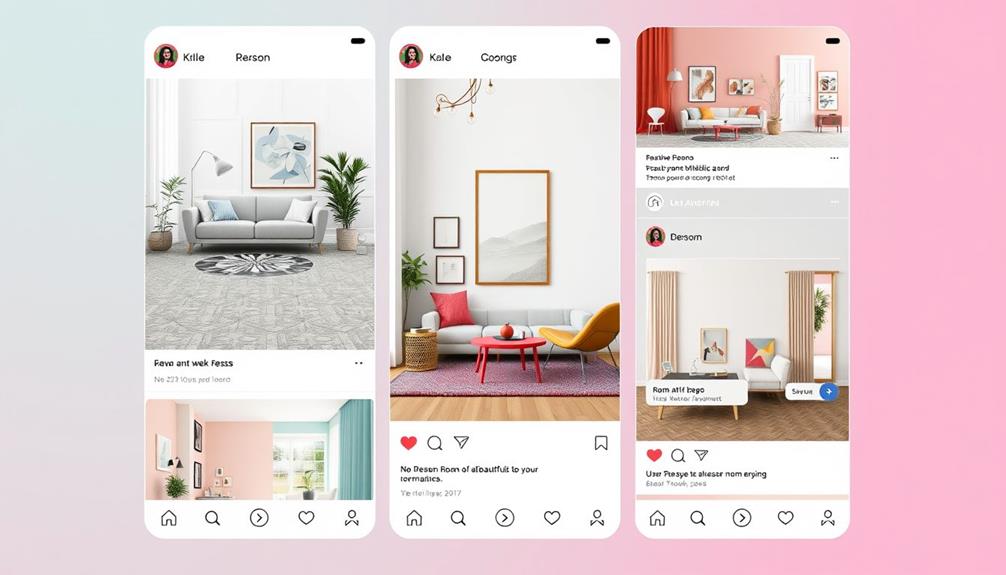
To boost your social media presence, focus on creating engaging content that resonates with your audience.
Use analytics tools to track what works and tweak your strategy accordingly.
Engaging Content Creation
In the dynamic world of interior design, engaging content creation is essential for standing out on social media. By leveraging AI for interior design, you can create tailored content that resonates with your audience.
Here are three strategies to boost your social media visibility:
- Showcase a Visual Portfolio: Use AI-generated imagery to create stunning visuals of your design projects. This eye-catching content attracts potential clients and demonstrates your expertise.
- Foster Audience Engagement: Actively respond to comments and messages to build a community around your brand. This interaction not only strengthens relationships but also encourages more conversations about your content.
- Utilize Hashtags Wisely: Research relevant hashtags like #interiordesign and #homedecor to expand your reach. Additionally, create a unique brand-specific hashtag to encourage user-generated content and promote engagement.
Analytics for Optimization
Analytics play an essential role in optimizing your social media engagement for interior design. By leveraging analytics tools, you can track engagement metrics and reach on platforms like Instagram and Pinterest. This allows you to make data-driven adjustments to your content strategies.
To elevate your social media game, consider the following strategies:
| Strategy | Description | Benefit |
|---|---|---|
| Monitor Audience Insights | Analyze when your audience is most active | Optimize posting schedules |
| Analyze Engagement Metrics | Identify which content types perform best | Refine overall strategies |
| Implement A/B Testing | Test different post formats and styles | Enhance content effectiveness |
| Regular Performance Assessment | Compare your results with industry benchmarks | Maintain competitive edge |
| Adjust Content Strategies | Adapt based on audience feedback and trends | Boost user interaction |
Utilizing audience activity insights enables you to optimize your posting schedules, increasing visibility. Regularly analyzing engagement metrics empowers you to refine your approach, ensuring continuous improvement. By implementing A/B testing, you'll discover what resonates best with your audience, enhancing your overall social media performance. Embrace these strategies to elevate your interior design brand online!
Conclusion
Incorporating AI into interior design can revolutionize your creative process, making it more efficient and innovative. Did you know that 76% of designers believe AI will greatly shape the future of design? Embracing these tools not only enhances your design capabilities but also keeps you ahead in a competitive market. So, whether you're using MidJourney or DALL·E 2, leveraging AI can help you craft stunning spaces that resonate with your clients and elevate your portfolio.

